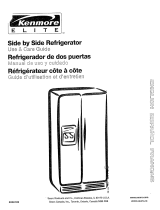
Food Storage Guide
There is a correct way to package and store
refrigerated or frozen food. To keep food fresher,
longer, take the time to study these recommended
steps.
Storing fresh food
Food placed in the refrigerator should be wrapped
or stored in air and moisture proof material. This
prevents food odor and taste transfer throughout
the refrigerator. For dated products, check code
date to ensure freshness.
Leafy vegetables
Remove store wrapping and trim or tear off
bruised and discolored areas. Wash in cold water
and drain. Place in plastic bag or plastic container
and store in crisper.
Vegetables with skins (carrots, peppers)
Store in crisper, plastic bags or plastic container.
Fruit
Wash, let dry and store in refrigerator in plastic
bags or crisper. Do not wash or hull berries until
they are ready to use. Sort and keep berries in
their store container in a crisper, or store in a
loosely closed paper bag on a refrigerator shelf.
Meat
Most meat can be stored in original wrapping as
long as it is air and moisture proof. Rewrap if nec-
essary. See the following chart for storage times.
Storage chart for fresh and cured meat*
TYPE APPROXIMATE TIME
(DAYS)
Chicken 1 to2
Ground beef 1 to2
Steaks and roasts 3 to 5
Cured meats 7to10
Bacon 5 to 7
Cold cuts. 3 to 5
Variety meats 1 to2
‘If meat is to be stored longer than the times given,
follow the directions for freezing.
NOTE: Fresh fish and shellfish should be used the
same day as purchased.
Store without washing in the original carton on
interior shelf.
Milk
Wipe milk cartons. For best storage, place milk on
interior shelf.
Butter or margarine
Keep opened butter in covered dish or closed
compartment. When storing an extra supply, wrap
in freezer packaging and freeze.
Cheese
Store in the original wrapping until you are ready to
use it. Once opened, rewrap tightly in plastic wrap
or aluminum foil.
Leftovers
Cover leftovers with plastic wrap or aluminum foil.
Plastic containers with tight lids can also be used.
Storing frozen food
The freezer section is designed for storage of
commercrally frozen food and for freezing food at
home. For further information about preparing
food for freezing, contact your local Cooperative
Extension Service or check a freezer guide or
cookbook.
Packaging
The secret of successful freezing is in the packag-
ing. The way you close and seal the package must
not allow air or moisture in or out. Packaging done
in any other way could cause food odor and taste
transfer throughout the refrigerator and drying of
frozen food.
Rigid polyethylene (plastic) containers with tight
fitting lids, straight-sided canning/freezing jars,
heavy-duty aluminum foil, plastic-coated paper
and nonpermeable plastic wraps (made from a
Saran film:i are recommended. Follow package or
container Instructions for proper freezing methods.
Do not use:
l
Bread wrappers
l
Non-polyethylene plastic containers
l
Containers without tight lids
l
Waxed paper
l
Waxed-coated freezer wrap
l
Thin, semi-permeable wrap
The use of these wrappings could cause food
odor and taste transfer and drying of frozen food.
Freezing
Do not expect your freezer to quick-freeze any
large quantity of food. Put no more unfrozen food
into the freezer than will freeze within 24 hours.
(No more than 2 to 3 pounds of food per cubic foot
of freezer space.) Leave enough space for air to
circulate around packages. Be careful to leave
enough room at the front so the door can close
tightly.
Storage limes will vary according to the quality
of the food, the type of packaging or wrap used (air
and moisture proof), and the storage temperature
which should be 0°F (- 17.8%). For further
information about food storage times, contact your
local Cooperative Extension Service or check a
freezer guide or cookbook.
16




















